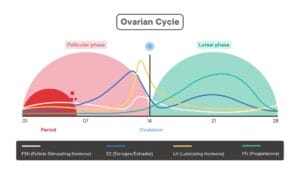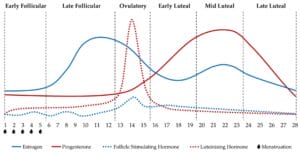Understanding the phases of your cycle can allow you to optimize training and performance.
As female athletes, you experience a series of hormonal shifts during your menstrual cycle particularly during the reproductive years. This influences various aspects of your physiology. By understanding the hormonal fluctuations that occur it can help to optimize your training and performance but also potentially mitigate possible injuries.
Organs Involved in the Menstrual Cycle
There are a variety of organs that play a role in the menstrual cycle, including the ovaries, uterus, pituitary gland and adrenal gland. Follicle Stimulating Hormone (FSH) and Luteinizing Hormone (LH) are hormones produced in the pituitary gland. While the adrenal gland produces the sex hormones (estrogen and progesterone) as well as cortisol. Depending on how high or low cortisol levels are within your body, this can impact your menstrual cycle. That’s why it’s important to understand how these hormones all interact with each other.
Phases of the Menstrual Cycle

The average menstrual cycle is 28 days and is divided into two main phases: the follicular phase and the luteal phase. The 2 phases are separated by ovulation.
Follicular Phase (Day ~1-14): from the start of the period until ovulation
This is the phase where follicles are stimulated for an egg to be released from the ovary.
- Day 1: Is marked by the start of menstruation. Menstruation can last on average for 3-7 days. During the first few days of the cycle, hormones are neutral as they are recalibrating for a new cycle.
- Day 7: As menstruation ends, estrogen begins to rise. Estrogen circulates through the bloodstream and will reach the brain, signalling the pituitary gland to produce FSH. FSH stimulates follicles in the ovary to grow and prepare the eggs for ovulation.
- Day 7-11: Estrogen spikes in the late follicular phase close to ovulation, which in turn causes the LH to spike. The follicular phase ends with a spike in LH, which promotes ovulation. Ovulation is an important part of the menstrual cycle as it is an indicator of a healthy menstrual cycle.
- Day 13-15: Midway through the menstrual cycle ovulation occurs. A dominant follicle (fluid filled sac containing eggs) bursts leaving the ovary and enters the fallopian tube with release of an egg from an ovary, which is known as ovulation.

Luteal Phase (Day ~15-28): from ovulation to just before start of menstruation
This is the phase where the body prepares the uterus for a possible pregnancy.
- Day 15/16: A rise in progesterone starts.
- Day 25: Hormones begin to tank, along with dopamine and serotonin levels. Hormonal changes can lead to common premenstrual symptoms such as mood changes, bloating and fatigue.
Key Hormones of the Menstrual Cycle: Estrogen & Progesterone
During the follicular phase estrogen is high and progesterone is low. While in the luteal phase estrogen is low and progesterone is low. These hormones have opposite effects on female physiology.
Estrogen
Healthy levels of estrogen in the body can:
- Increase bone density
- Impact mental function and cognition
- Increase insulin sensitivity
- Increase leptin production and sensitivity (helps control hunger)
- Prevent inflammation and limit muscle damage
Progesterone
Effects of progesterone include:
- Conversion into aldosterone, cortisol (stress hormone) and the androgens
- Increases in body temperature
- Increases in feelings of hunger
- Prevents testosterone from binding to androgen receptor
- Decrease in progesterone which inhibits melatonin, which can negatively impact sleep
Hormone Fluctuations and their Impact on Training & Strength
Each individual experiences the effects of the fluctuation in hormones differently in terms of duration and intensity. This allows you to modulate training loads and effort as well as recovery as much as possible depending on which phase of the cycle you are in.
Menstruation:
- This is when hormones are recalibrating
- Energy is improving, hormones (estrogen) is starting to increase
- Most people will feel good when their period comes after the first day or two
- What does that mean for training: Extra rest is not needed at this time due to the increase in energy levels.
Follicular Phase:
- Higher testosterone during this time (receptors are more sensitive to testosterone)
- You’ll feel strong
- Higher pain tolerance
- What does that mean for training: Gradually increasing load for strength training.
Ovulation:
- Estrogen is at its peak
- You may be able to lift the most during this time
- High levels of estrogen can make tendons more stretchy which can lead to a possible increase in injury
- What does that mean for training: Possible personal bests may be achieved due to the high levels of estrogen and its effects on energy. Playing certain sports that include pivoting may increase potential risk of injury due to the effect of estrogen on tendons and ligaments.
Luteal Phase:
- Progesterone is rising, which may lead to an increase in fatigue
- What does that mean for training: may need more intentional rest, attention should be paid to one’s fatigue levels. Athletes can still go to the gym and push themselves within their tolerance.
Key Points Regarding Training & The Menstrual Cycle
- Track your cycle to allow you to be more in tune with your body
- Pay attention to how your body is feeling
- Be well fueled when you train
- There will be ebbs and flows of your mood, energy levels based on your hormones but don’t restrict yourself from training.
Living in alignment with the menstrual cycle is important and allows for you to plan training and life events around your cycle. Taking on big tasks during the luteal phase can be tougher versus follicular phase. Appreciate the ebbs and flows of the cycle and take appropriate rest breaks when needed through your training as well as in life!
About the Author:
Yatrika Gosai
Registered Physiotherapist
Book with Yatrika at our Spadina Location!
References:
Laurie Ray, D., & Morgan Michalowski, C. (2024, July 18). The menstrual cycle, explained. The Menstrual Cycle: Phases of Your Cycle. https://helloclue.com/articles/cycle-a-z/the-menstrual-cycle-more-than-just-the-period
McLaughlin, J. E. (2022, September). Menstrual cycle – menstrual cycle. Merck Manual Consumer Version. https://www.merckmanuals.com/home/women-s-health-issues/biology-of-the-female-reproductive-system/menstrual-cycle
Xanne A. K. Janse de Jonge. (2012, September 23). Effects of the menstrual cycle on Exercise Performance – Sports Medicine. SpringerLink. https://link.springer.com/article/10.2165/00007256-200333110-00004

